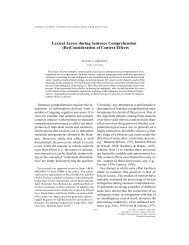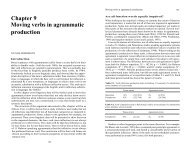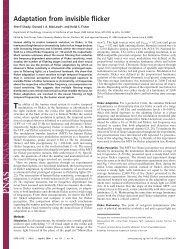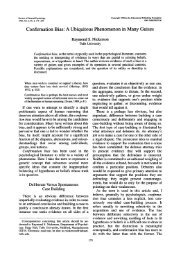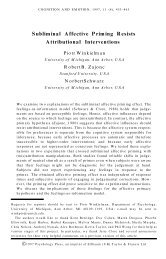4 Lexical Processing and Sentence Comprehension in Aphasia
4 Lexical Processing and Sentence Comprehension in Aphasia
4 Lexical Processing and Sentence Comprehension in Aphasia
Create successful ePaper yourself
Turn your PDF publications into a flip-book with our unique Google optimized e-Paper software.
4. LEXICAL PROCESSING AND SENTENCE COMPREHENSION 131base for <strong>in</strong>dependent, (but, of course, unconscious) decision processes. Thepo<strong>in</strong>t is to avoid commitment to a wrong word sense that will requirebacktrack<strong>in</strong>g.It was <strong>in</strong> the context of these f<strong>in</strong>d<strong>in</strong>gs <strong>and</strong> attendant speculation that weaga<strong>in</strong> exam<strong>in</strong>ed our mechanistic, account of agrammatism. The questionswe posed were: Is the failure of agrammatic patients to access normallyclosed-class items a failure restricted to that doma<strong>in</strong>? Or is the problemmore pervasive, affect<strong>in</strong>g properties of open-class access as well as closedclassaccess? Are they deficient, that is, <strong>in</strong> all language activities that dem<strong>and</strong>rapid process<strong>in</strong>g-not only <strong>in</strong> the rapid (possibly, simultaneous)access of closed-class items for the purpose of phrasal assignment, but also<strong>in</strong> the exhaustive access of ambiguous open-class items? And, aga<strong>in</strong>, if adisruption to such <strong>in</strong>itial process<strong>in</strong>g stages is found to occur, is it restrictedto agrammatism or does it accompany aphasia <strong>in</strong> general?Act<strong>in</strong>g on these questions, we prepared sentences for aural presentationconta<strong>in</strong><strong>in</strong>g lexical ambiguities of the aforementioned type (<strong>in</strong>deed, <strong>in</strong>clud<strong>in</strong>gthe example given); <strong>and</strong> we used the CMLP paradigm where<strong>in</strong> the visuallypresented target items dem<strong>and</strong><strong>in</strong>g a lexical decision appearedimmediately after the ambiguous word <strong>in</strong> the sentence. We tested neurologically<strong>in</strong>tact patients, agrammatic, <strong>and</strong> Wernicke's aphasic patients. And tobuttress our <strong>in</strong>structions that they were not just to wait for the letter str<strong>in</strong>g,but to try also to underst<strong>and</strong> each sentence, each subject was asked at severalpo<strong>in</strong>ts dur<strong>in</strong>g the experimental session to "say <strong>in</strong> your own words whatyou have just heard."The neurologically <strong>in</strong>tact patients showed prim<strong>in</strong>g for both senses ofeach ambiguous word. Their data, <strong>in</strong> short, uphold earlier <strong>in</strong>dications thatlexical access momentarily <strong>in</strong>volves the exhaustive retrieval of <strong>in</strong>terpretationsof a lexical item <strong>and</strong> that such retrieval is not <strong>in</strong>fluenced by contextual<strong>in</strong>formation. More generally, these normal data susta<strong>in</strong> the notion of a languagecomprehension system organized <strong>in</strong> terms of encapsulated (autonomous)processesor modules, <strong>and</strong> they susta<strong>in</strong> its corollary, that contextualconstra<strong>in</strong>t is not <strong>in</strong>troduced wherever potentially useful, but only after theaccess processes have done their work. That is, context is <strong>in</strong>troduced as ameans of select<strong>in</strong>g among compet<strong>in</strong>g representations provided by an <strong>in</strong>dependentprocess<strong>in</strong>g device.The fluent Wernicke's aphasic patients also showed prim<strong>in</strong>g for bothsenses of ambiguities. Aga<strong>in</strong>, as <strong>in</strong> the letter detection task, we found nocompell<strong>in</strong>g evidence of a disruption at <strong>in</strong>itial stages <strong>in</strong> which form-basedword retrieval processes are active. Rather, <strong>and</strong> now with some cumulativeforce, we are led to the conclusion that the Wernicke's limitation is to be locatedelsewhere, somehow <strong>in</strong>volv<strong>in</strong>g either the formation of semantically<strong>in</strong>terpretable structures based on data provided by the encapsulated lexicalaccess system or the capacity to draw <strong>in</strong>ferences from such structures.The agrammatic patients, by contrast, did show a disruption at the stage



